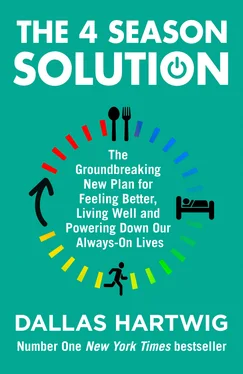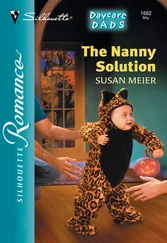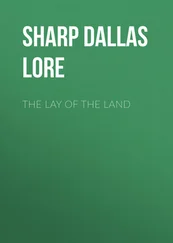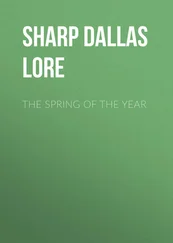In every way I could think of, I started to honor the natural rhythms, both on the daily and seasonal levels. The deeper I got into it, the more I realized that I had embarked on a journey with some profoundly countercultural implications. Many of us today have a hard time slowing down. We stay in a frenetic, stimulating, always-on, multitasking kind of mode in terms of how we sleep, eat, move, and connect (or… don’t). Because we’re stuck in this pattern of perpetual “summer” behavior, our deepest needs aren’t being met, and we feel unsettled and unmoored, adrift in the world of working, trying to have fun, and seeking “happiness.” We often become addicted to artificial substitutes for those needs—refined sugar instead of complete protein, caffeine instead of restful sleep, daily spin classes instead of picking up heavy things, social media instead of real, face-to-face contact. In the broadest sense, we’re even addicted to this kind of fast-paced existence itself, maintaining it even though we notice that it exhausts us, leaves us out of balance, and ultimately threatens our health. It feels good and bad at the same time, but we simply don’t know what to do differently. This is just what we’re supposed to do, right?
In my experiments, I sped my life up at certain times but slowed down at others, as our ancestors did. I made my life more intense and challenging at certain points, and much more restorative and restful at others. I aimed for excitement and adventure and growth at certain times, calmness and placidity and quiet withdrawal at others. I was still living what most people would consider a “normal” life, but beneath the surface I was doing many things very differently than others around me. The more I experimented, the more I saw the ancient wisdom of a more natural, oscillatory way of life. And the more I learned about natural rhythms, the more I experimented. A positive dynamic took hold that left me feeling more energetic and creative, but also more peaceful, rested, grounded, and connected with others. My mood improved, as did my focus. Everything felt better. And I wasn’t trying nearly as hard to maintain healthy habits as I had been before. Because I was making incremental changes that felt intuitively right to me and that helped me feel better, I owned those changes in a whole new way. How could I not behave in these ways, now that I knew that it made me feel deeply better? Living well became far easier and more fun than it had ever been before.
I knew I was onto something, and I was excited to tell others about it. So, I began to present my ideas at academic conferences. My friend and colleague Jamie Scott, a health researcher based in New Zealand, and I presented a talk on the seasonal model for health at the Ancestral Health Symposium to a packed house. The simple-but-profound approach resonated deeply with people, and they told me that I was presenting a new paradigm for thinking about living in a more integrated fashion. They were excited and urged me to write a book on the subject. The momentum was building. And then… I did nothing.
Well, not exactly. For a number of years, I put my new, integrative model aside and focused on one particular piece of it, the part dealing with food. Many readers will know me for having coauthored the bestselling books It Starts with Food and The Whole30. These books, which empowered people to bring their diets in tune with their bodies’ innate needs, were key components of my four-part rhythmic model. In 2011, when I was working on It Starts with Food, I didn’t merely think of the word “it” as meaning “good health.” To me, “it” also meant dedication to rhythmically attuned living. If you want to bring your body in harmony with its natural rhythms, you can’t do it with the wave of a magic wand, or simply by adhering to a new shopping list. It has to happen incrementally as you learn, unlearn, relearn, and eventually integrate lessons along the way. If you could only pick one place to start, my training, research, and personal experience all told me that this should be diet. It starts—but certainly doesn’t end—with food.
The thirty-day Whole30 experiment clearly emphasizes diet. Over a monthlong period, we ask participants to radically change their dietary habits, avoiding all alcohol, legumes, grains, sugars and refined sweeteners, dairy products, and artificial additives (like carrageenan and MSG). In their place, we tell people to stock up on healthy fats, meat, seafood, poultry, veggies of all types, fruit, and nuts and seeds. I always considered this diet part of a larger, fully integrated program of behavior change and self-awareness, aimed at empowering people by helping them rediscover what their own bodies were telling them. That’s why we discouraged any “fake treats,” like Paleo waffles made from mashed bananas, or pizza crust fashioned from a crushed cauliflower. Consuming such foods followed the letter of the law but definitely not the spirit of the program, which wasn’t to imitate conventional or junk food products, but to entirely reimagine your attitude toward food and your own health. It’s also why we eliminated all the most commonly problematic foods that cause digestive issues, like gluten and dairy, allowing people to create a clean digestive slate, and then progressively, little by little, to reintroduce certain foods after the thirty days and see how they felt, both physically and emotionally. To be sure, some people who embraced the Whole30 did so because they wanted to attain specific health objectives such as losing weight or relieving disease symptoms, but that was never my deepest intention. With the Whole30 program, I sought to give people some initial tools for becoming more aware of their own bodies’ inherent needs, so that they could feel empowered to take steps on their own to satisfy those needs, become healthier, and even more important, live a life of purpose and deep joy. The Whole30 was just the beginning of the beginning.
The 4 Season Solution is the book I imagined writing almost a decade ago—the prequel to It Starts with Food , really. The book presents my four-part theory and introduces a groundbreaking health approach that you can deploy immediately to achieve steady, sustainable gains over time. Within my framework, you attend to your health and well-being in a personalized way, on your own terms, and without requiring doctors, coaches, or other outside experts. Whether you’ve struggled to stay well or you simply want to be living better than you currently are, The 4 Season Solution will cast new light on your current health behaviors and how they might be undermining your goals and values. The book will also show you how to start changing those behaviors so that you can progress toward many important goals at once—better sleep, a healthier weight, more energy, brighter skin, deeper meaning and purpose, lower stress, and a greater sense of connectedness, contentment, and peace.
Leaning into Wellness
Many people who completed the Whole30 program have written to me to describe the transformative changes they have seen in their lives—changes that went far beyond the food they eat. For some, the opportunity to learn how their diet affected them individually led them to rethink unhealthy relationships and to improve them. Others were moved to start exercising, stop smoking, go to graduate school, or pursue creative endeavors that they had long neglected. What I’ve found absolutely fascinating and inspiring is that Whole30 participants consistently took on these higher-order growth opportunities once the roadblock of their unhealthy diet was removed. Repeatedly, people posed this question: “I’ve changed my diet, and I feel so much better. What can I do next?” Clearing the fog caused by problematic foods allowed them to spontaneously and energetically pursue other avenues of growth and meaningful experiences.
Читать дальше












